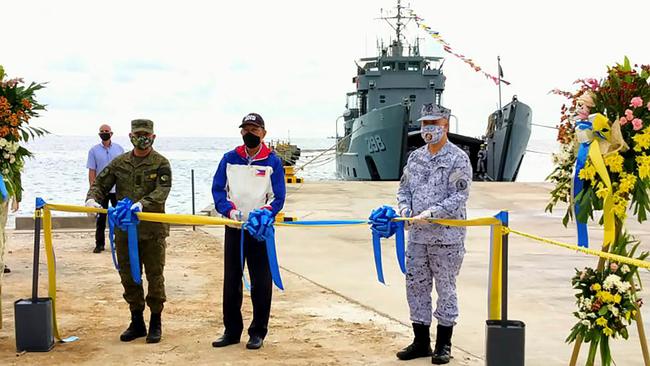Philippines spends $45m for navy to meet force with force in South China Sea
The Philippines will spend $US31m ($44.5m) bolstering its military infrastructure on a disputed island in the South China Sea.

The Philippines will spend $US31m ($44.5m) bolstering its military infrastructure on a disputed island in the South China Sea in a move widely seen as pushback against the recent escalation of Chinese aggression in the region.
Defence Secretary Delfin Lorenzana announced the project on Pag-Asa island (also known as Thitu) after unveiling a beaching ramp that will allow all-weather naval access to an area that has become a flashpoint as Chinese fishing boats and coastguard ships have swarmed nearby waters.
The timing of the announcement was highly significant: a year after a Chinese coastguard vessel rammed and sank a Filipino fishing boat, leaving 22 crew members marooned, and on the day that Manila and Beijing marked 45 years of diplomatic ties.
General Lorenzana denied the works would militarise the island, though they are widely expected to raise hackles in Beijing, which has been accused of capitalising on the distractions caused by the coronavirus pandemic to consolidate its disputed claims over more than 90 per cent of the South China Sea.
In recent months a Chinese warship has trained its radar guns on a Philippines naval vessel, a Chinese coastguard ship has rammed and sunk a Vietnamese fishing boat, while a flotilla of Chinese militia and coastguard ships trailed and harassed a Malaysian oil and gas surveying vessel.
The US has responded by ratcheting up its military presence in the South China Sea, deploying US navy ships and air force B-1 bombers to signal to Beijing that it intends to remain in the region.
China’s announcement of two new administrative districts over occupied islands in the strategic waterway forced Philippines President Rodrigo Duterte last week to reverse his own decision to end a defence treaty with the US that underpinned the two countries’ historic alliance.
There are also reports Beijing is preparing to declare an air defence identification zone over the Pratas, Paracel and Spratley island chains that it has occupied and militarised in recent years.
Announcing such a zone would be seen as highly inflammatory by rival claimants of those islands — Vietnam, The Philippines, Brunei, Malaysia and Taiwan — and a signal that China was prepared to defend it.
General Lorenzana said the purpose of the infrastructure works on Pag-Asa was “to develop a safe, viable community”.
“We will not militarise this, like (with) cannons, missiles,” he added of the island, which lies 227 nautical miles from The Philippines and 540 nautical miles from China’s Guangdong province.
Philippines security analyst Richard Heydarian said China’s recent acts of aggression in the region had forced a shift in Manila.
Mr Duterte, a champion of closer relations with China, was facing heightened domestic pressure over what many saw as his acquiescence to Beijing, despite a landmark 2016 UN arbitration commission ruling that China’s claims over islands in Philippines’ waters had “no legal basis”.
“Not even someone as strong-willed as President Duterte could hold the line on China because China is not making it easy for its allies,” Professor Heydarian said.
“China’s aggression has been so brazen that it has punctured any illusion you can just talk nice to them and de-escalate the situation. It is not surprising that Indonesia, Malaysia and even The Philippines are beginning to fortify their positions,” he said, referring to Jakarta’s UN protest last week over China’s so-called Nine Dash Line map and Malaysia’s recent submission to extend the limits of its continental shelf.
“China has overreached and caused a backlash. The only problem is, at the moment, it is an unco-ordinated pushback but hopefully as the pandemic subsides we might see a more co-ordinated regional effort together with the US to keep China’s force instincts in check.”




To join the conversation, please log in. Don't have an account? Register
Join the conversation, you are commenting as Logout